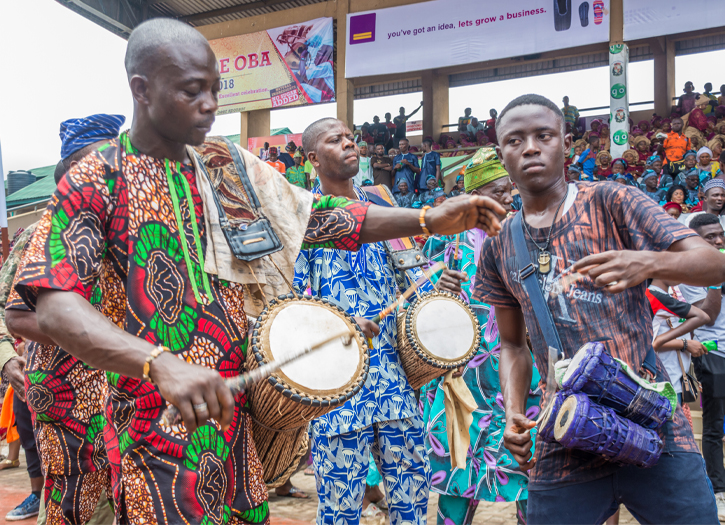The talking drum is an hourglass-shaped drum from West Africa, whose pitch can be regulated to mimic the tone and prosody of human speech.
It has two drumheads connected by leather tension cords, which allow the player to change the pitch of the drum by squeezing the cords between their arm and body.A skilled player is able to play whole phrases. Most talking drums sound like a human humming depending on the way they are played. Hourglass-shaped talking drums are some of the oldest instruments used by West African griots and their history can be traced back to the Bono people, Yoruba people, the Ghana Empire and the Hausa people. The Yoruba people of south western Nigeria and Benin and the Dagomba of northern Ghana have both developed a highly sophisticated genre of griot music centering on the talking drum .
In Senegalese and Gambian history, the tama was one of the music instruments used in the Serer people‘s “Woong” tradition (the “dance performed by Serer boys yet to be circumcised” or the future circumcised, also known as the “Xaat” in the Serer language).The tama drum, has Serer religious connotations (which predates the Ghana Empire). In the Xaat tradition, the tama makes up the fourth musical drum ensemble. The Serer drums played include : Perngel, Lamb, Qiin and Tama.Ayangalu is believed to have been the first Yoruba drummer. Upon his death he was deified, and so now he is counted among the ranks of the Orishas. It is believed by followers of the Yoruba religion that he is the patron spirit of drummers.
The pitch of the drum is varied to mimic the tone patterns of speech. This is done by varying the tension placed on the drumhead: the opposing drum heads are connected by a common tension cord. The waist of the drum is held between the player’s arm and ribs, so that when squeezed the drumhead is tightened, producing a higher note than when it’s in its relaxed state; the pitch can be changed during a single beat, producing a warbling note. The drum can thus capture the pitch, volume, and rhythm of human speech, though not the qualities of vowels or consonants.
The use of talking drums as a form of communication was noticed by Europeans in the first half of the 18th century. Detailed messages could be sent from one village to the next faster than could be carried by a person riding a horse. In the 19th century Roger T. Clarke, a missionary, realised that “the signals represent the tones of the syllables of conventional phrases of a traditional and highly poetic character.”Like Chinese, many African languages are tonal; that is, the pitch is important in determining the meaning of a particular word.The Yoruba language, for instance, is mostly defined by the tri-tonic scale, consisting only of the tonic sol-fa notes, do, re, mi, different inflections of which are then used to convey different messages.







Add Comment